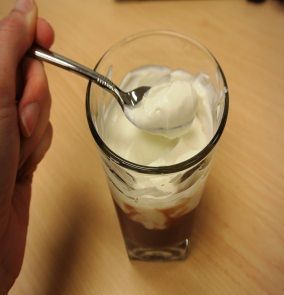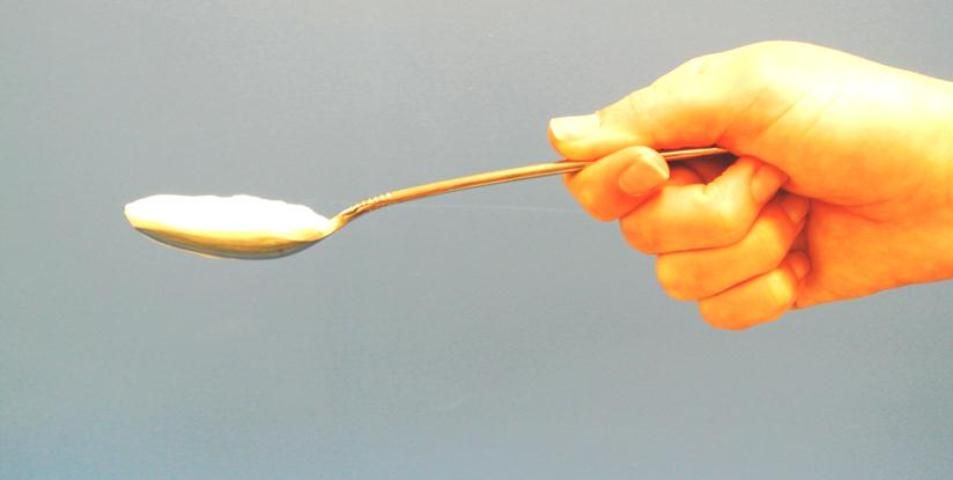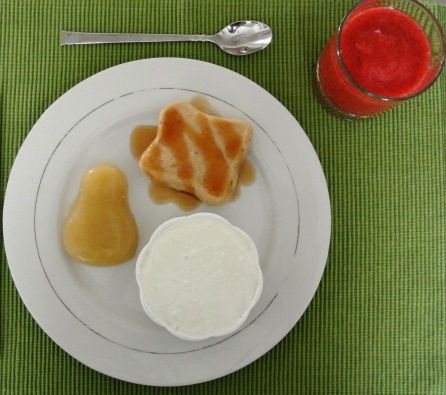What is a puréed food?
A puréed food is a food item that has been blended, mixed, or processed into a smooth and uniform texture. Examples of foods with a purée consistency include applesauce, pumpkin pie filling, and hummus. Puréed foods may be necessary for people with chewing or swallowing problems (ADA 2002).

Credit: UF/IFAS
For those requiring a puréed diet, it is important to provide a variety of foods. Almost any food can be puréed. However, some puréed foods may be much more acceptable than others.
Equipment to Prepare a Purée
Foods may be puréed using a blender or food processor.
Blenders
- Best for liquid foods (milkshakes, sauces, fruit purées/smoothies, soups)
Food Processors
- Best for most foods (vegetables, meats, crackers/breadcrumbs)
- Good for chopping, slicing, and shredding foods prior to puréeing
Steps to Prepare a Puréed Food

Credit: UF/IFAS
- Weigh or measure the number of portions required for the recipe. (Canned foods may need to be drained.)
- Process items in a food processor until they are fine and homogenous in texture.
- If the purée is too thick or too thin, take the necessary steps to get the purée to the proper consistency.
If too thick: Add measured amounts of hot liquid for cooked foods and cold liquid for cold foods. Add small amounts at a time so as not to make the purée too thin. Reprocess until smooth.
If too thin: Measure and add commercial thickener or natural food thickener (see below). Add small amounts at a time so as not to make the purée too thick.
4. Reprocess until smooth.
5. Add any flavors, dried or ground herbs, or spices, and process again until very smooth.
If serving immediately, portion purées with a scoop of appropriate size and garnish as desired. If shaping the purée, pour it into food molds. If storing for later use, refrigerate or freeze the purée following food safety guidelines.
Finding the Right Consistency
Preparing a puréed food with optimal texture is important for safe swallowing. Food may need to be thickened or thinned depending on individual recommendations.
Puréed foods that are too thin may be difficult for some people to swallow. It is often easier to control and swallow thicker food because it moves more slowly through the swallowing process. Puréed foods that are too thick may also be difficult to swallow. It is very important to create palatable and "safe-to-swallow" purées that have the right consistency (i.e., not too thin and not too thick).
In general, puréed food should have a uniform texture that is "spoon thick" and should not require chewing. It should not be dry, sticky, or lumpy. Consistency may need modification to suit individual needs.
Why use thickeners?
Thickeners are used in the preparation of puréed foods to prevent water separation and to keep the puréed food from being too thin or runny. There are several options for thickeners, including commercial and natural food thickeners. Commercial thickeners include starch- and gum-based thickeners. Natural food thickeners include finely crushed crackers, cereals, and puréed beans.
Starch Thickeners
Starch thickeners are powders that are made of 100% modified starch. Examples of commercially available starch thickeners are Thick-It® and ThickenUp® and various store brands.
Advantages
- Simple to measure and mix into foods and beverages
- How-to guides are available to determine the amounts to add to thicken various foods and beverages
Disadvantages
- Provides only starch and no other nutrients
- May create undesirable texture or suppressed flavor
- May thicken over time, resulting in a product that is too thick
- May not mix well with very acidic foods and beverages (e.g., orange juice)
Gum thickeners
Gum thickeners are made primarily of xanthan gum and water. Commercial products include ThickenUp Clear® and SimplyThick®.
Advantages
- Provide no calories
- Simple to measure
- How-to guides are available to determine amounts to add to thicken various foods and beverages
- Do not thicken over time
Disadvantages
- May give undesirable, off-flavors
- May be difficult to achieve uniform thickening
- May not mix well with oral nutritional supplements (e.g., Ensure® or Boost®)
Other Thickening Options
Blended or powdered foods often can be used to thicken purées, adding taste and nutrients. Examples include the following:
Powders
- Finely ground crackers/breadcrumbs/cookies
- Baby cereals
- Finely ground breakfast cereals
- Dried vegetable powders
- Potato flakes
Purées
- Puréed canned or cooked beans
- Puréed starchy vegetables (e.g., canned pumpkin, potato)
Advantages
- Provide additional nutrients, which are important for people with swallowing problems and limited food intake
- Produce a desirable texture that will not thicken over time
- May enhance flavor
Disadvantages
-
No how-to guides are available; recipes must be developed to prepare tasty purées with the appropriate texture
Goals of Puréed Food Production
- Puréed foods should be made with very similar textural characteristics each time they are prepared and served. The best way to prepare puréed foods is to develop standard, tested recipes. Recipes are important to ensure the purée has an acceptable taste and texture. The texture should be smooth, cohesive, and the appropriate "spoon-thick" consistency every time the puréed food is prepared. A spoon test can be used to test the consistency of small batches of food.

Credit: UF/IFAS
2. A yogurt- or pudding-like consistency is considered "spoon thick" and is the proper texture for purées.
3. Puréed foods should be prepared with optimal flavor, appearance, and aroma. If the food does not look or smell good, it probably will not be eaten. If the food passes the visual and aroma test, it probably will be eaten.
Try edible garnishes with a suitable puréed texture to enhance the overall appeal of the purée. Excellent options include sauces, gravies, and any food or condiment of purée consistency that can improve appearance and flavor.

Credit: UF/IFAS
The acceptability of flavor and texture determines whether the purée will be eaten. Sensory testing and recipe development are the keys to ensuring that puréed foods are acceptable and appealing.

Credit: UF/IFAS
Where can I get more information?
The Family and Consumer Sciences (FCS) agent at your local UF/IFAS Extension office may have more written information and nutrition classes for you to attend. Also, a registered dietitian (RD) can provide you with reliable information.
Resource
National Dysphagia Diet Task Force (2002). National Dysphagia Diet: Standardization for Optimal Care. Chicago, IL: American Dietetic Association.